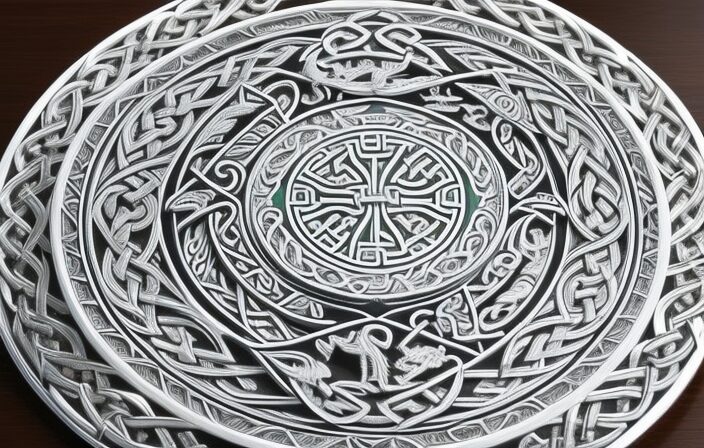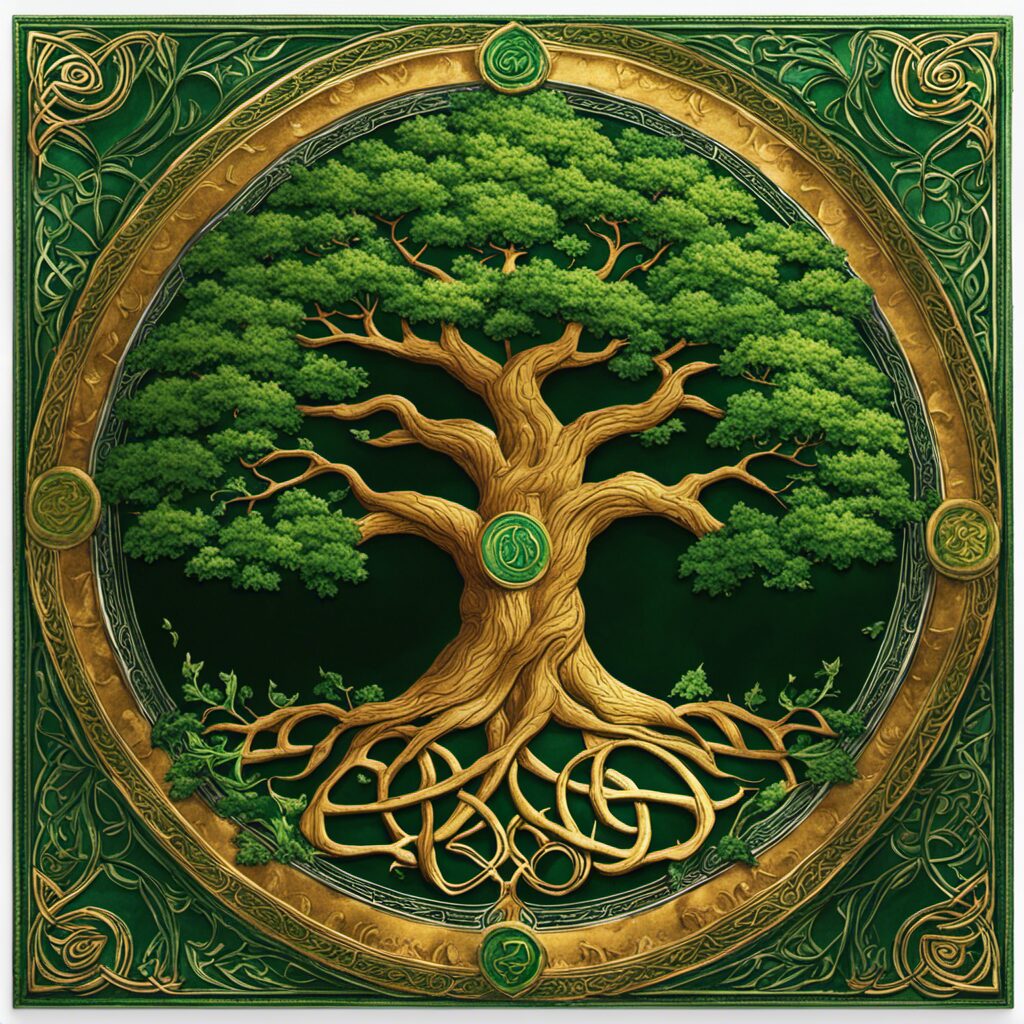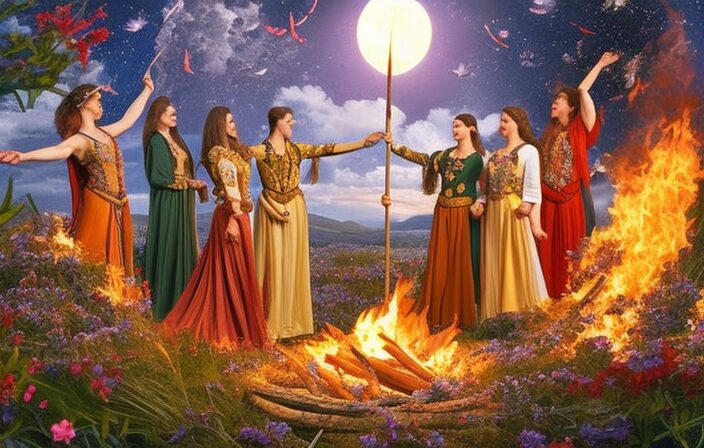In the realm of historical study, the Celtic calendar system stands as an intriguing and enigmatic subject. Like a labyrinthine puzzle waiting to be unraveled, its origins, functions, and effects on daily life have long fascinated scholars.
This article serves as a comprehensive introduction to the Celtic calendar system, examining its historical background, lunar cycle, significant dates and festivals, connection with nature, and impact on everyday existence.
By delving into these aspects with objectivity and thoroughness, we aim to shed light on this intricate web of timekeeping that shaped the lives of ancient Celts.
Key Takeaways
- The Celtic calendar system originated from ancient Celtic cultures and incorporated lunar phases and solar cycles.
- Lunar phases played a significant role in determining important events and activities in Celtic culture.
- Festivals in the Celtic calendar were marked by significant celestial events and seasonal changes, providing opportunities for communal bonding and seeking guidance.
- The Celtic calendar system had a profound influence on daily life, guiding agricultural practices and serving as important cultural and social gatherings.
The Origins of the Celtic Calendar System


The origins of the Celtic calendar system can be traced back to ancient Celtic cultures and their observations of celestial events. The Celts were an ancient Indo-European people who inhabited large parts of Europe during the Iron Age. They had a deep connection with nature and believed that celestial events held significant meanings. Influenced by their agricultural practices, the Celts developed a lunar-solar calendar system that incorporated both lunar phases and solar cycles.
The Celtic calendar consisted of twelve months, each based on a particular natural event or agricultural activity. These months were interwoven with the movements of the moon and the sun, creating a complex but precise system for tracking time. This calendar was essential for determining important dates such as planting seasons, harvest times, and religious festivals.
When compared to other ancient calendar systems like those used by the Egyptians or Mesopotamians, the Celtic calendar stands out for its focus on nature and its strong connection to agricultural practices. While other ancient civilizations also had lunar or solar calendars, the Celtic calendar uniquely combined these elements to create a comprehensive timekeeping system that influenced many aspects of daily life.
Understanding the Celtic Lunar Cycle
One way to gain insight into the Celtic lunar cycle is by examining its unique characteristics and patterns. The Celtic calendar system was heavily influenced by celestial bodies, particularly the moon. The lunar phases played a significant role in determining important events and activities within the Celtic culture.
-
Importance of Lunar Phases: The Celts believed that the moon had a profound impact on various aspects of their lives, including agriculture, hunting, and religious ceremonies. They closely observed the changing appearances of the moon to determine favorable times for planting crops or embarking on hunting expeditions.
-
Lunar Divisions: The Celtic calendar was divided into months known as ‘moon periods’ or ‘moons.’ Each moon period began with a specific lunar phase, such as the new moon or full moon. These divisions helped them track time and plan their activities accordingly.
-
Ritualistic Significance: Lunar phases held great ritualistic significance in Celtic spirituality. Full moons were considered sacred and celebrated with elaborate ceremonies and gatherings. They believed that during these times, the veil between the physical world and spiritual realm was thin, allowing for enhanced communication with deities and ancestors.
Understanding the unique characteristics of the Celtic lunar cycle provides valuable insights into how celestial influences shaped their daily lives, cultural practices, and spiritual beliefs.
Important Dates and Festivals in the Celtic Calendar
Important dates and festivals in the Celtic calendar were marked by significant celestial events and seasonal changes. These festivals held great cultural significance for the Celtic people, as they celebrated important moments in their agricultural cycle and religious practices.
One such festival was Samhain, which marked the end of the harvest season and the beginning of winter. It was believed that during this time, the boundaries between the living and spirit worlds were thin, allowing spirits to cross over into our realm.
Another prominent festival was Imbolc, which heralded the arrival of spring and celebrated the lactation of ewes. This festival symbolized purification and new beginnings.
Beltane, on the other hand, marked the midpoint between spring equinox and summer solstice. It was a celebration of fertility and abundance, with rituals involving bonfires to cleanse past negativity and ensure a fruitful year ahead.
The Celtic festivals not only reflected their deep connection with nature but also had social implications within their communities. These gatherings provided an opportunity for people to come together, strengthen communal bonds, share stories, exchange goods, engage in games or competitions, make offerings to deities or spirits for blessings or protection, seek guidance from druids or wise elders through divination practices.
The Role of Nature in the Celtic Calendar System


Nature played a central role in shaping the festivals and dates of the Celtic calendar, with celestial events and seasonal changes serving as key markers for these significant cultural celebrations. The ancient Celts were deeply connected to their natural surroundings, relying on the rhythms of the seasons for survival and prosperity. Their calendar was closely tied to agricultural practices, reflecting their reliance on farming and animal husbandry.
-
Seasonal Celebrations: The Celtic calendar revolved around the four major seasonal transitions – Samhain (winter), Imbolc (spring), Beltane (summer), and Lughnasadh (autumn). These festivals marked important moments in the agricultural cycle, such as sowing seeds, harvesting crops, or preparing livestock for winter.
-
Celestial Events: The movements of celestial bodies were also instrumental in determining festival dates. Alignments of stars and planets were observed by ancient Celts to predict favorable times for planting or reaping. Equinoxes and solstices held particular significance as they marked pivotal points in the solar year.
-
Agricultural Practices: The festivals themselves were intricately linked to agricultural activities and celebrated with rituals aimed at ensuring successful harvests or protecting livestock from harm. Offerings were made to deities associated with fertility and growth, while bonfires were lit as symbols of purification and renewal.
The Celtic calendar system thus represented an intricate fusion of nature’s cycles with human endeavors, embodying a profound connection between people’s lives and the natural world around them.
How the Celtic Calendar System Influenced Daily Life
The influence of the Celtic calendar on daily life can be observed through its integration into agricultural practices, seasonal celebrations, and celestial event observations.
The Celtic people had a deep connection with nature and believed that the movements of the celestial bodies had a direct impact on their lives. Astrology played a significant role in their understanding of the world, and they assigned specific meanings to each Celtic zodiac sign.
In terms of agriculture, the Celtic calendar guided farmers in determining the best times for planting, harvesting, and tending to crops. Each season was associated with specific activities such as sowing seeds or preparing fields for cultivation. This allowed them to optimize their yield and ensure food security throughout the year.
Seasonal celebrations were an integral part of Celtic culture, marking important moments in the agricultural cycle. These events celebrated fertility, abundance, and renewal. They often involved rituals honoring deities associated with growth and harvest.
Observing celestial events such as solstices and equinoxes was another way in which the Celts connected with their calendar system. These astronomical occurrences were seen as significant markers of time that influenced both natural phenomena and human destiny.
Overall, the Celtic calendar played an essential role in shaping daily life by providing guidance for agricultural practices, inspiring seasonal celebrations rooted in nature’s cycles, and acknowledging celestial events tied to astrology and cosmic influences.
Conclusion
The Celtic calendar system, with its roots in ancient times, offers a fascinating glimpse into the lives and beliefs of the Celtic people. Its lunar cycle guided their understanding of time and shaped their important dates and festivals.
Nature played a significant role in this system, connecting the Celts to the natural world around them. With its influence on daily life, the Celtic calendar system was intricately woven into the fabric of their society.
Exploring this ancient system allows us to appreciate the rich cultural heritage that it embodies.




